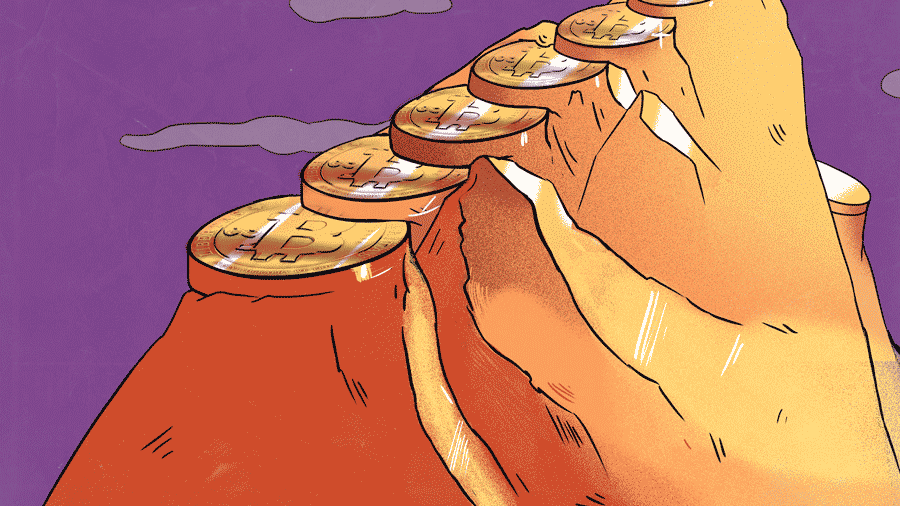By Haohan Xu
Bitcoin has been in the news more than ever as the price of the first-ever cryptocurrency has surged in the last six months. This price explosion has been driven largely by institutional investors moving into the space, with corporate buyers like Tesla and MicroStrategy helping drive industry awareness and growth.
Subscribe to the Crunchbase Daily
Investors are pursuing new and innovative ways to increase their holdings in Bitcoin, and one of the most popular is to invest in bitcoin mining.
Mining bitcoin is the process of adding another block of data to a blockchain — a distributed ledger. To do so, a highly specialized computer solves a ridiculously complex mathematical equation. Each attempt to solve the equation is called a “hash,” and the overall activity on the network is referred to as “hash rate.” The miner who eventually solves the equation is rewarded with new bitcoin.

Similar to how central banks “create” money, mining generates new cryptocurrency. However, unlike banks and fiat currencies, there is a cap on the total amount of bitcoin that will ever exist: 21 million. There are currently more than 18.5 million bitcoin in existence, leaving fewer than 2.5 million to be created.
Currently, a new block is created about every 10 minutes, meaning around 900 BTC are allocated every day. Each block receives a reward of 6.25 BTC, equivalent to roughly $358,000 as of this writing. With bitcoin prices near $60,000, that’s approximately $54 million being generated daily.
To buy or mine?
In the same way that investing in a gold mine offers unique advantages to buying gold directly, investments in bitcoin mining offer advantages over buying Bitcoin directly or purchasing shares in a Bitcoin investment trust like Grayscale Bitcoin Trust.
The most obvious benefit to investing in mining is the constant stream of bitcoin being generated, regardless of price. Traditional investors must make risky determinations regarding price movements, hoping to “buy the dip” as the market continues to climb.
Miners, however, are shielded from price fluctuations by the consistent influx of bitcoin at market value, which is a solid addition to any portfolio. While price volatility impacts overall portfolio value, the consistent and market-relative output from mining investments makes them an effective hedge against volatility.
Hardware mining and mining pools
Traditional bitcoin mining operations involve significant capital expenditures like mining hardware and storage facilities that keep the hardware running smoothly. For example, hardware machines called ASICs (Application Specific Integrated Circuits) cost as much as $10,000 to get the highest possible hashrate.
ASICs also require substantial maintenance with temperature-controlled facilities to keep them running at optimal levels, and must be replaced over time as new hardware becomes available.
With such high up-front investment costs, some investors have sought out mining pools where groups of miners pool their collective hashrates digitally to increase profits. Still, investors must buy and maintain efficient hardware to maintain high profitability.
Because of the constant changes in technology and efficiency, some companies have sought to standardize mining hashrates based on the computing power of specific units. This standardized, persistent model offers a fixed return of bitcoin for the various amounts of hashrate power going into a given mining pool.
Mining equity and hashrate tokens
A newer form of mining investment is through indirect participation in mining companies, or mining equity. This form of investment is similar to owning stock in a company producing a product. For example, companies that own and maintain a substantial amount of Bitcoin mining machines can offer investors indirect participation through the sale of equity positions in their respective firms.
However, this model does not guarantee a standardized, persistent result in the same way that mining pools offer.
Other companies, seeking to maintain the benefits of standardization and persistence for investors, have offered standardized hashrate tokens. This token model allows investors to participate in mining activities as though they are miners, but without the complexity of hardware ownership and upkeep.
Tokens also ensure investors a guaranteed amount of hashrate power (input) every day and their fair share of mined bitcoin, uniting the benefits of indirect investment with direct mining operations.
A digital gold rush
As mainstream adoption of Bitcoin continues, so too will investments in various forms of mining — especially if the price of bitcoin continues to rise. Whether direct hardware mining, mining pools, mining equity, or standardized hashrate tokens, strong returns will entice investors who are part of the accelerating “digital gold rush.”
Haohan Xu is CEO of Apifiny, a global digital asset trading network. Prior to Apifiny, Haohan was an active investor in equities markets and a trader in digital asset markets. Haohan holds a bachelor’s of science degree in operations research with a minor in computer science from Columbia University.
Illustration: Li-Anne Dias

Stay up to date with recent funding rounds, acquisitions, and more with the Crunchbase Daily.



![Illustration of a guy watering plants with a blocked hose - Global [Dom Guzman]](https://news.crunchbase.com/wp-content/uploads/quarterly-global-3-300x168.jpg)
67.1K Followers